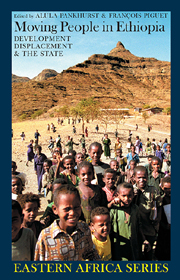Book contents
- Frontmatter
- Contents
- Acknowledgements
- Acronyms
- Glossary
- Notes on Contributors
- Preface: An Original Contribution to Country-wide Displacement Analysis
- Foreword by Alula Pankhurst & François Piguet
- Map
- Part I INTRODUCTION
- Part II THEORETICAL & INTERNATIONAL PERSPECTIVES
- Part III DEVELOPMENT-INDUCED DISPLACEMENT
- Part IV THE EXPERIENCE OF STATE-ORGANIZED RESETTLEMENT
- Part V THE DILEMMAS OF REFUGEES, RETURNEES & DISPLACED GROUPS
- Part VI CONCLUSION
- 16 Displacement, Migration & Relocation
- Bibliography
- Index
- EASTERN AFRICAN STUDIES
16 - Displacement, Migration & Relocation
from Part VI - CONCLUSION
Published online by Cambridge University Press: 05 April 2013
- Frontmatter
- Contents
- Acknowledgements
- Acronyms
- Glossary
- Notes on Contributors
- Preface: An Original Contribution to Country-wide Displacement Analysis
- Foreword by Alula Pankhurst & François Piguet
- Map
- Part I INTRODUCTION
- Part II THEORETICAL & INTERNATIONAL PERSPECTIVES
- Part III DEVELOPMENT-INDUCED DISPLACEMENT
- Part IV THE EXPERIENCE OF STATE-ORGANIZED RESETTLEMENT
- Part V THE DILEMMAS OF REFUGEES, RETURNEES & DISPLACED GROUPS
- Part VI CONCLUSION
- 16 Displacement, Migration & Relocation
- Bibliography
- Index
- EASTERN AFRICAN STUDIES
Summary
In our Introduction we started by placing the key issues within a broader historical, geographical and theoretical framework of migration. We now return to the topic with a view to drawing insights from the case studies and recent research to provide suggestions based on past experience and current trends to inform debates on research, policy and practice.
To contextualize the issues, we start by providing an overview of the major topics discussed in the chapters, making the case for a more holistic approach that considers the various types of forced migration together and within the same framework as spontaneous and voluntary migration. For each topic we review recent developments and changing trends, noting that development-induced displacement in its various manifestations has become the most significant type of movement, replacing earlier concerns with resettlement, refugees, returnees and demobilization. This shift is beginning to be noticed by researchers but to date has no been sufficiently reflected in policy considerations. This may be in part because the forms of displacement are fragmentary and widespread and because development-induced displacees are among the poorest and most voiceless, whose rights may be in contradiction with national and international interests, and on whose behalf there is often limited advocacy within the country and internationally.
- Type
- Chapter
- Information
- Moving People in EthiopiaDevelopment, Displacement and the State, pp. 246 - 264Publisher: Boydell & BrewerPrint publication year: 2009



